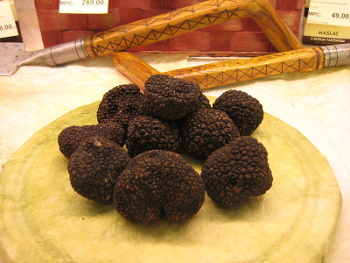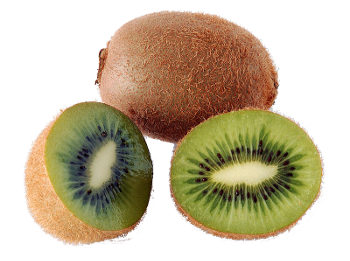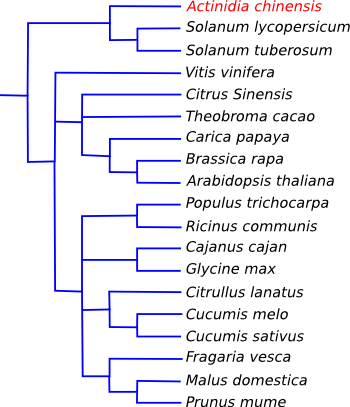Truffles and Chinese Gooseberries
October 22, 2014
Bacteria are sometimes treacherous, as when they cause
infection, but they are sometimes useful.
Baker's yeast gives us
bread, and
vintner's yeast gives us
wine.
Science facilitates
winemaking, as it does for every
industrial process.
Oenology, a word derived from the
Greek, οινος (wine) and λογια (study of), is the science of
winemaking.
The bacteria in wine are just there for their ability to produce
ethanol from
sugar, but some bacteria impart
flavor to
food.
Cheese is made from
milk by several methods, but one of these is the use of
fermentation bacteria to convert the milk sugar,
lactose, into
lactic acid. The lactic acid
curdles the milk, and the bacteria impart flavor. One cheesemaking bacteria is
Lactococcus.
The
truffle, the
fruiting body of the
Ascomycota fungus, is a prized and expensive food additive whose price is nearly that of
gold. Truffles are a good example of the
economic principle that scarcity will force an increase in price until an
equilibrium of
supply and demand is reached.
Cultivation of truffles is difficult, since they are found only in
symbiotic association with the
roots of certain
trees, such as
oak,
hazelnut,
beech and
birch.

Black truffles from Istria, Croatia.
(Wikimedia Commons image by Sl-Ziga.)
Truffles are prized for their flavor, and a recent study by
scientists from the
Georg-August University of Goettingen (Goettingen, Germany), the Institute for Molecular Biosciences (
Frankfurt am Main, Germany), and the
Université de Lorraine (Champenoux, France) has shown that the flavor of white truffles comes mostly from soil bacteria trapped inside the truffle fruiting bodies.[1-2] A report on this
research is contained in a recent issue of the
journal,
Environmental Microbiology.[1]
White truffles from the
Piedmont region of Italy are the most expensive class of truffle, costing about 5,000
Euros/
kilogram. The less expensive (2,000 Euros/kilogram) black truffles are found in the
Périgord region of Southern France. The research team studied the white truffle,
Tuber borchii, which is native to
Europe but is now cultivated in
New Zealand and
Argentina.[2]
It's been suspected for the last
decade that bacteria might contribute to truffle flavor. The study identified
thiophenes,
sulfur-containing
volatile chemicals produced by bacteria.[1] These volatile sulfur compounds make up a portion of the distinctive truffle
smell.
Pigs and
dogs are able to find truffles, which grow underground, because of the sulfur smell.[2]
One test of this
hypothesis was to treat the truffles with
antibacterial agents. The antibacterial agents fully suppressed the production of thiophene volatiles, while application of
fungicide had no affect.[1] Says
Richard Splivallo, a study author from the Georg-August-University,
"However, our results cannot be transferred to other types of truffles because the compounds we investigated are only found in the white truffle Tuber borchii... We don't just want to know which part of the truffle flavor is produced by bacteria. We are also interested in how the symbiosis between fungi and microorganisms has evolved and how this benefits both symbiotic partners."[2]
This research was funded by the
German Research Foundation (Deutsche Forschungsgemeinschaft).
Have you ever eaten a
Chinese gooseberry? It's likely that you have, but didn't realize it, since these are now known as
kiwifruit. Kiwifruit, the
fruit of the the
Actinidia chinensis, is native to
China, but it was first produced in New Zealand in 1906. By a clever
rebranding in 1974 to identify it with the cute,
flightless kiwi bird, this fruit has gained considerable
market share. Nearly 1.5 million
tons of kiwifruit are produced
annually.

Whole and cut kiwifruit.
(Wikimedia Commons photo by André Karwath, via Aka.)
The kiwifruit has a high
vitamin C content, and Actinidia chinensis has become an important model plant for studies in the production of vitamin C,
carotenoids and
flavoloids. That's why an International Kiwifruit Genome Consortium (IKGC) was initiated in 2011 to
sequence the whole
genome of Actinidia chinensis. A draft of this genome has just been published by a large international team of scientists from twelve institutions, including
Hefei University of Technology (Hefei, China),
Sichuan University (Chengdu, China), and
Cornell University (Ithaca, New York).[3-6]
A Chinese variety of the kiwifruit plant, “Hongyang,” was used to produce the draft sequence. The genome was found to have a total length of 616.1
mega-base-pairs (Mb) and it contains 39,040
genes.[3] For comparison, the
human genome is about 3,200 Mb long, and it contains just 20,000–25,000
protein-coding genes. Kiwifruit has many genetic similarities to other plant species, including
potatoes and
tomatoes.[5]
Kiwifruit diverged from the tomato and potato in a way that modified its vitamin C, flavoloids and carotenoids.[3] About 8,000 genes are found to be in common with tomato,
rice,
grape, and the mustard weed,
Arabidopsis.[5]

The kiwifruit plant (Actinidia chinensis) has many familiar cousins, as shown in this taxonomic tree.
Shown here are Solanum lycopersicum (tomato), Solanum tuberosum (potato),Vitis vinifera (common grape vine), Citrus Sinensis (orange), Theobroma cacao (cocoa tree), Carica papaya (papaya), Brassica rapa (turnip family),Arabidopsis thaliana, Populus trichocarpa (western balsam poplar),Ricinus communis (castor oil plant), Cajanus cajan (pigeon pea), Glycine max (soybean), Citrullus lanatus (watermellon), Cucumis melo (muskmelon), Cucumis sativus (cucumber), Fragaria vesca (strawberry), Malus domestica (apple), and Prunus mume (Chinese plum). (Adapted from fig. S1 of the supplementary information for ref. 3, in turn based on published sources.)[4].)
The
data showed that about 80 million years ago there was an extensive expansion of genes when an entire extra copy of the genome was added. This event was followed about 27 million years ago by an extensive gene loss.[5] When genes are duplicated like this, the extra genes can
mutate to perform new functions. This
neofunctionalization was beneficial to kiwifruit.[5]
Says
Zhangjun Fei, a study
author and an
associate professor at Cornell University, “The duplication contributed to adding additional members of gene families that are involved in regulating important kiwifruit characteristics, such as fruit vitamin C, flavoloid and carotenoid metabolism.[5]
References:
- Richard Splivallo, Aurélie Deveau, Nayuf Valdez, Nina Kirchhoff, Pascale Frey-Klett, and Petr Karlovsky, "Bacteria associated with truffle-fruiting bodies contribute to truffle aroma," Environmental Microbiology Early View (2014), doi: 10.1111/1462-2920.12521).
- On the trail of the truffle flavor - Soil bacteria contribute to the taste and smell, Goethe University Frankfurt Press Release, September 30, 2014.Press release in German can be found here.
- Shengxiong Huang, Jian Ding, Dejing Deng, Wei Tang, Honghe Sun, Dongyuan Liu, Lei Zhang, Xiangli Niu, Xia Zhang, Meng Meng, Jinde Yu, Jia Liu, Yi Han, Wei Shi, Danfeng Zhang, Shuqing Cao, Zhaojun Wei, Yongliang Cui, Yanhua Xia, Huaping Zeng, et al., "Draft genome of the kiwifruit Actinidia chinensis," Nature Communications, vol. 4, article no. 2640 (October 18, 2013), doi:10.1038/ncomms3640. This is an open access article with a PDF file available here.
- Supplementary Information for ref. 3 (PDF File).
- Melissa Osgood, "Surprises discovered in decoded kiwifruit genome," Cornell University Press Release, October 25, 2013.
- Kiwifruit Genome Database at Cornell University.
Permanent Link to this article
Linked Keywords: Bacteria; infection; baker's yeast; bread; fermentation; vintner's yeast; wine; science; winemaking; industrial process; oenology; Greek language; ethanol; sugar; flavor; food; cheese; milk; fermentation starter; lactose; lactic acid; curd; Lactococcus; truffle; sporocarp; fruiting body; Ascomycota; fungus; gold; macroeconomics; economic principle; economic equilibrium; supply and demand; cultivation; mycorrhiza; symbiotic association; root; tree; oak; hazelnut; beech; birch; Istria; Croatia; Wikimedia Commons; Sl-Ziga; scientist; Georg-August University of Goettingen (Goettingen, Germany); Frankfurt am Main, Germany; Université de Lorraine (Champenoux, France); research; scientific journal; Piedmont region of Italy; Euro; kilogram; Périgord region of Southern France; white truffle; Tuber borchii; Europe; New Zealand; Argentina; decade; thiophene; sulfur; volatile organic compound; volatile chemical; odor; smell; pig; dog; hypothesis; antibacterial; fungicide; Richard Splivallo; German Research Foundation (Deutsche Forschungsgemeinschaft); Chinese gooseberry; kiwifruit; fruit; Actinidia chinensis; China; rebranding; flightless bird; kiwi bird; market share; ton; annual; Aka; vitamin C; carotenoid; flavoloid; sequence; genome; Hefei University of Technology (Hefei, China); Sichuan University (Chengdu, China); Cornell University (Ithaca, New York); base-pair; gene; human genome; protein biosynthesis; protein-coding; potatoes; tomatoes; rice; grape; Arabidopsis; Actinidia chinensis; Solanum lycopersicum (tomato); Solanum tuberosum (potato); Vitis vinifera (common grape vine); Citrus Sinensis (orange); Theobroma cacao (cocoa tree); Carica papaya (papaya); Brassica rapa (turnip family); Arabidopsis thaliana; Populus trichocarpa (western balsam poplar); Ricinus communis (castor oil plant); Cajanus cajan (pigeon pea); Glycine max (soybean); Citrullus lanatus (watermellon); Cucumis melo (muskmelon); Cucumis sativus (cucumber); Fragaria vesca (strawberry); Malus domestica (apple); Prunus mume (Chinese plum); data; mutation; mutate; neofunctionalization; Zhangjun Fei; author; associate professor.